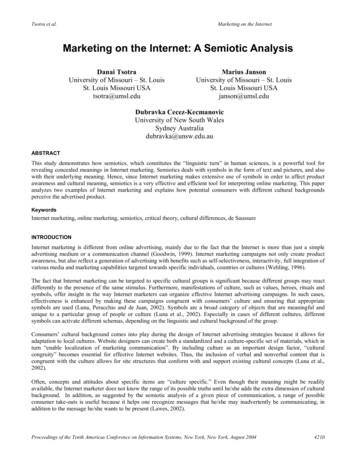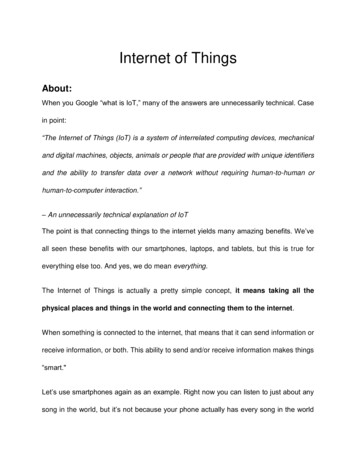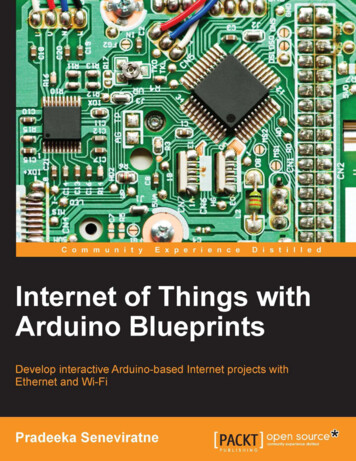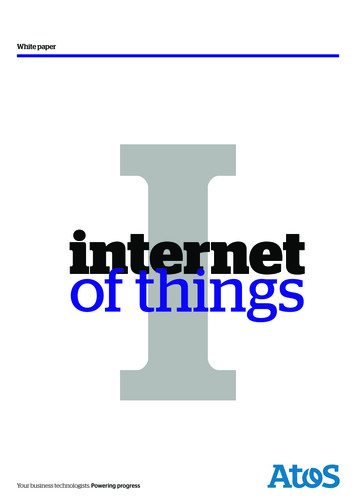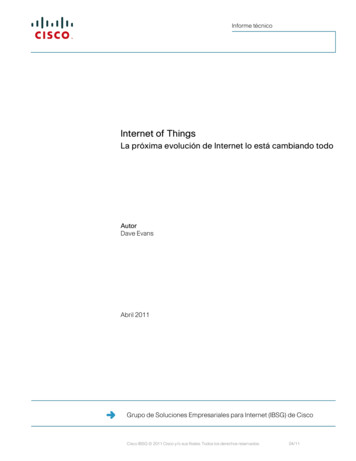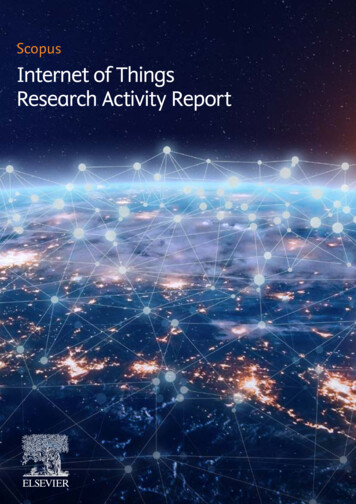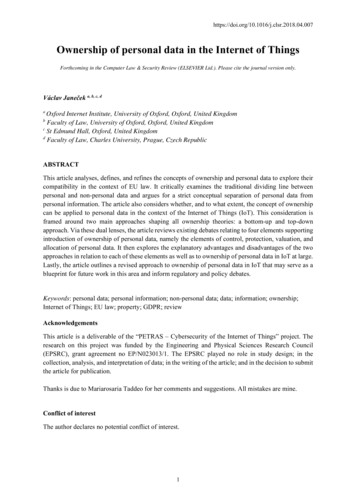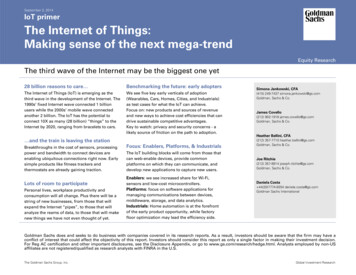
Transcription
Proceedings of INTCESS 2017 4th International Conference on Education and Social Sciences6-8 February 2017- Istanbul, TurkeyINTERNET OF THINGS AS SEMIOTIC PHENOMENONYury ShaevAssoc. prof., Pyatigorsk State University, Russia, existentia20065@yandex.ruAbstract“Internet of Things” is a concept of computer network of devices and objects. “Things" can exchangeinformation between themselves and between the environment, regulate their functioning. Moreover, in theframework of the Internet of Things can be implement a digital marking of the world. The trends of thedevelopment are so high, that virtual reality extends to many areas of reality and through labelling is trying toinclude the largest possible number of objects in the universe of information.This work is related to the semiotic analysis of the concepts and components of the Internet of things. In thiscontext, we can consider the exchange of information between "things" as a kind of message interchanging.As part of this approach we analyse the phenomenon of the digital marking and identification of objects ofvarious natures with special RFID tags. We distinguish and describe the principle of iconicity in theframework of the Internet of things. The semiotic analysis of the technology and the phenomenon of theInternet of things is very relevant in today's society in a situation of erosion of the foundations of social life,increasing attention to the "things" of reality as such, and their peculiarities.Keywords: Internet of Things, Information technologies, Digital marking, Semiotic, Computer technologies1. INTRODUCTIONThe life of modern man cannot be imagined without information technologies today. The increasing roleamong information technologies in everyday life and in industrial production begins to play the Internet ofThings (IoT). Internet of Things is a concept of computer network facilities, which involves the exchange ofdata between devices- “things” (may take place the data exchange between the devices and thetechnological chain nodes and the external environment, the interaction with the environment - informationalor physical) with the use of network technologies mainly the Internet. This exchange of data often doesn’tinvolve human intervention, or is minimized; the person serves as a designer of technological processes, oras the user.In industrialized countries, Internet of Things concept is used in industrial production. Many theorists andpractitioners noted that the introduction of this technology already had made a revolution in the field ofISBN: 978-605-64453-9-21060
Proceedings of INTCESS 2017 4th International Conference on Education and Social Sciences6-8 February 2017- Istanbul, Turkeyconstruction of the technological chain of production and logistic processes, or make it in the near future [1,p.11]. In the frame work of Internet of Things are used different technological platforms and paradigms. Forexample in the industrial Internet of Things B2B paradigm is used, and in “civil” sector, the paradigm isknown as B2C. The last involves the use of Internet of Things in daily life, management of urbaninfrastructure elements, residential facilities. These include the so-called «smart» houses, equipped withtemperature sensors, illumination, state of the locks, engineering infrastructure of the house in the frameworkof which the kind of self-regulation of the modern human dwellings takes place. It involves the regulation ofclimate, lighting, and the possibility of remote control of electronic devices and actively uses the Internet toexchange data. To this segment can be also attributed, such gadgets as smart watches, fitness braceletsthat monitor in real-time basic biological parameters, the state of the body's systems, the level of consumedcalories, followed by data collection and analysis in the framework of special applications for smartphones.The great prospects for development of the Internet of things in such areas as, for example, medicine andtransportation are obvious. Thus, within the framework of the Internet of Things can take place the dataexchange between objects in relative independence from the man, “things” (here it is possible to think overthe obvious connotations of the philosophical concept of “thing” as the substantial and often sensiblecomponent of the reality).We can say that things form a specific network of interactions in which people can act as one of the nodes ofthe network. Internet things in this respect can be regarded as a kind of ontological and social phenomenon,as it creates a new configuration of people’s and thing’s being. Socio - ontological meaning of thisphenomenon is seen in the two modes.First, a person is acting as an integral part of the structure or network among the “things”. To some extent,the man also becomes a “thing”, an element in the system of information flow. The principle of functioning ofthe Internet of Things resembles transmission of essential and relevant information, which using a datatransfer protocol should be clearly understood and used by network nodes. It is appropriate to draw a parallelwith the semiological notion of code as the principle that determines the place of the sign in sign system, therules of symbols combining for creating semantic integrity and creating messages.We should notice that the impact of information technologies reached such level that the man himself is nowtrying to exchange only with relevant information, all that is “semiotic excess data” may be rejected. Perhapsthat is why the slang of gamers, hackers and IT-specialists not only abound in technical terms and jargon,but also tend to sense capacitance and, often, lack lyrical digressions. One reason for this situation can bealmost ubiquitous information noise accompanying the exponential increase of information flows in themodern world. In a situation of strong noise on the information space, a person has consciously rebuild themode of perception and generation of the information.2. INTERNET OF THINGS AS SEMIOTIC PHENOMENONIf we turn to the deeper ontological foundation of this phenomenon, it is possible to detect the deformation ofthe ontological image of modern man. Now we are increasingly turning into a formal set of identificationcharacteristics and parameters, we do not always think through the deeper aspects of life, do not deal withreflections on existential questions that predicted by M. Heidegger, argues that people are increasinglygiving the most important considerations at the mercy of “other” “people” (das Man), dissolving its existencein an environment of generally accepted worldview and behavioral patterns [6, p.126-130].Referring to the semiotic tradition in the spirit of the semiotics of Pierce, within these concept a person isseen as a sign, that as something referring to something else. We should mention that Pearce analyzed as asign a kind of complex formation, the main feature of which is a reference to other signs (as a signs heunderstood a variety of phenomena) [9, c. 18-22]. The man, in this sense, serves as a sign too, as a complexset of “hyperlinks” cultural contact points, behavioral, philosophical models [2, p. 194]. Perhaps this is one ofthe reasons of identity crisis in the social aspect and of the destruction of social ontology as an unshakablebelief in the existence of social relations.Secondly, as part of the Internet of things, a person himself creates the network and tries to control them. Inthis respect man-actor represent a scientist who in the Actor-network concept of B. Latour creates a wholescientific and socio-cultural network of interactions. Even in the “Pasteurization of France” Latour describedthe discovering of bacteria by L. Pasteur [11]. He noticed that a scientific discovery – is a combined result of"forces" actions, including, in addition to purely research interest - unsatisfactory level of hygienedevelopment, economic interest of agricultural producers “activity” of the microbes themselves that areactively breeding in established researchers favorable laboratory environment.ISBN: 978-605-64453-9-21061
Proceedings of INTCESS 2017 4th International Conference on Education and Social Sciences6-8 February 2017- Istanbul, TurkeyPersuading various social groups in reality of microbes, hygienists, headed by Pasteur achieved thatmicrobes came to be regarded as a dangerous reality. Moreover, they moved the scientific "network"laboratories in real life - actively used methods of pasteurization, the hotels began to monitor the cleanlinessof bed linen, etc. In his works, Latour develops idea of the network as a combination of elements of variousnatures that interact and ensure sustainability of the network. For example the facts, confirming theconclusions of the scientific principles and practical achievements in the application of technologies,scientific and Publication apparatus of theoretical science as a totality of views of the scientists, makingopposition to the “theoretical” network against costly and unpromising by some theorists who haveundertaken to refute the theoretical concepts, financial support from foundations and the state, and etc. [10,p.259]. Very important in this theory is the concept of "machine" or a device (as an example we can mentionthe diesel engine) as a black box, which through its successful operation provides stability of the entirenetwork [3, p. 282-333]. If you try to extrapolate these thoughts on the peculiarities of Internet of things, itmay be noted that many, if not all, elements of the Internet of Things, are important nodes, many of themhave an “artificial intelligence” in the process of information exchange and management of interactions withother elements [1, p.11]. The network acts as a kind of self-regulating structure that supports a number ofaspects of the functioning of its elements.Science Network as a public institution is stable thanks to a number of factors: the universality of thelanguage (especially natural sciences), verifiability and reproducibility on the empirical level, many of theprovisions, and systemic support to the scientific tradition.If we try to extrapolate the model of scientific network on the Internet of things, it may be noted that theInternet of things now receives such a development, in many ways, thanks to the universality of the protocols(B2B, B2C), to provide data exchange within its "civil" and industrial sectors. In the industrial segment of theInternet of Things are developed software products that enable not only the automatic control, but also todetermine the possibility of reorganization of the production process on the basis of the so-called algorithmspredictive analytics (predictive analytics), and large numbers of neural computation theory. The possibility ofintegration of electronic equipment, which also provides rapid development and stability of the networkstructure of the Internet of Things, seems promising for us.Finally, there is the interest of the political structures in the implementation of the Internet of Things, as itimproves control over segments of society and realizes the bio-political control mechanisms associated withdata analysis, correlated with the needs and interests of the people, what is technologically possible in thefield of statistical analysis, for example, web serfs of a user. In this respect, the technology of Internet ofThings is interested not only for the government, but also for business, and, above all, for the largecompanies that use advanced information technologies in the advertising and PR-strategies.Another reflection concerning correlation of actor-network theory and the concept of Internet of Things is thetranslation problem. Within the framework of his theory Latour talks about “translating” of what that “inform”the objects with which deals the science. First the translation is made to the science language with the use ofterminology, graphical tools, and other things, and then it is translated into a general cultural context [3, p.179-233], in which the results of the research have the status of “reality” and begin to be recognized in nonscientific circles. For example, complex investigations in the field of genetics, requiring huge financialinvestments, qualified staff, an extensive network of scientific communication continues to function as anordinary representation and segments of the scientific picture of the world in the mass consciousness, someare used in marketing strategies (such as labeling, indicating the absence of “genetically modifiedorganisms”), focused on the patterns formed by the perception of everyday consciousness.Latour, in his theory, tries to justify the idea that the reality in which man lives, is a multilevel, hybrid, it mixeddifferent subject perspectives, correlated with the areas of study of various sciences [4]. In this he is close toShchedrovitsky, who noted in human activity the source of the breakdown in the different regions and subjectfield, if we talk about the “positive” science [7, 8] - the origin of the different ontologies and reflexive position.Latour on the contrary evaluates human activities "for sketching" the validity of the field meanings in anegative sense. That means that the “things” are often unable to speak for themselves and, as a rule,scientists and thinkers, carrying hermeneutic activity interpret “physis” on their own. This can be applied toboth: to the natural sciences, which generalize and empirical evidence conceptualized and to humanities,where the hermeneutic work is noticeable and can be very ambiguous, for example, in a situation ofinterpretation of the results of sociological research. Developing the idea of interactions within society, Latourreflects on the social world as a totality of “human” and “non-human” actions, i.e. things, objects which areembedded in networks of social interaction.ISBN: 978-605-64453-9-21062
Proceedings of INTCESS 2017 4th International Conference on Education and Social Sciences6-8 February 2017- Istanbul, TurkeyLatour suggests the idea of the “parliament of things” in which “things” should be considered as a social andnetworking elements of natural and cultural interactions [12, p. 166-180]. As a rule, scientists and thinkersrepresent them in acts of interpretation, semantic and practical positioning in the system of the activities.Latour proposes to make the process transparent, so to develop methods for the representation of thecomplex structure of social situations in the framework of which will be displayed a complex natural-socialcharacter of many urgent problems of reality. We think this means the need for restructuring of thought andthe leaving the strict opposition of “nature”, “culture” in the classic sense, understanding the mechanisms ofinclusion of “things” in the development of socio-hermeneutical procedures, the formation of a strong cultureof social reflection.Of course, there are many questions about the possibility of forming a culture of thinking and the use of suchpractices, for example, in real-existing institutions of political representation. However, attention to the“things”, a sort of sociological and socio-philosophical twist to the ontology of “things”, which cannot besubject to the ontology of social relations (as in the classical concept) is quite symptomatic and reflects thedeep ontological changes in the modern world, in the scientific and philosophical practices of rethinking. Inthis sense, the Internet of Things is a good example of the potentialities of “things” that begin to play anincreasingly important role in the real world, and not in the abstract and philosophical sense, but as a socialactors, which are rebuilding the contours of social ontology. As part of the Internet of Things “things”themselves, i.e. devices often manage without “logos” in cooperation with each other and only in thesituation of human contact is required verbal language, and even then not in all cases.It is significant that now many gadgets have visual-sensory interfaces that correlate with the iconic principleof the interaction. Itself the Internet of Things involves that the gadgets and technical devices are equippedby sensors that collect information and transmit it to other devices. Russian word “датчик” can be translatedinto English as “sensor”. Can be thought that the “things”, like a technical devices interact with thesurrounding space through the “touch contact” (i.e., by means of sensors capacity) and data transfer. Aspecial case of sensory contact – is a contact with a finger or with other part of the body while using thetouch screen, for example of the smartphone. Things thus interact directly with each other, transforming thedata into binary code. The human communication involves verbal code, culture is almost completelylogocentric.3. CONCLUSIONSThis problem itself - the dialectic of verbal and iconicity is complicated and requires a separate study. Wecan note that the reduce of culture in modern society, the approach of the daily practices of communicationto the type of information transmission in the network connecting device, in some measure is due to theimpact of technologies on the lives, and on the contours of the human being. But the culture continues tobase on powerful logocentric foundations, which can’t disappear in the near future.Thus, the actor-network theory is a methodological concept and, at the same time, provides an ontologicalcomponent associated with an attempt to give a new ontological contour to the network socio-cultural hybridreality ontology as a totality of people and “things”. In this regard, some approaches can be used to describethe concept of the Internet of Things and simulated some general or particular technological aspects. TheInternet of Things are often reinterpreted, mostly by engineers or experts who argue in the spirit of scientificand technological optimism, not paying attention to the social and ontological aspects of the introduction ofthe Internet of Things. We believe that the analysis of socio-technological phenomena of the Internet ofThings ontological offers the prospect of a better understanding of the place and the impact of informationtechnologies on the various segments of society, understanding the causes and consequences of thetransformation of the socio-ontological foundations of modern society.REFERENCE LISTIndustrial Internet of Things (2016). Control Engineering Russia, vol 1.Kiryushenko, V. (2008). The language and the sign in pragmatism. Saint-Petersburg: European university ofSaint-Petersburg, 199 p.Latour, B. (1988). Science in action. Harvard University press.Latour, B. (1993). We have never been modern. Translated by Catherine Porter. Cambridge, Massachusetts:ISBN: 978-605-64453-9-21063
Proceedings of INTCESS 2017 4th International Conference on Education and Social Sciences6-8 February 2017- Istanbul, TurkeyHarvard University Press,Latour, B. (2005). Reassembling the social: an introduction to actor-network-theory. Oxford New York:Oxford University Press.Haidegger, М. (1997). Being and time. Moscow: Ad Marginem.Shchedrovitsky, G. (2005). The sign and the action. Moscow: Orient literature.Shchedrovitsky, G. (1995). Selected works. Moscow.Deledalle, G. (2000). Charles S. Peirce’s Philosophy of Signs.: Bloomington, Indiana University Press.Latour , B. (1986) Laboratory life. The construction of scientific facts. Princeton: Princeton University Press.Latour, B. (1988). Pasteurization of France. Cambridge: Harvard University Press.Latour, B. (2004). Politics of nature. How to bring the sciences into democracy. Cambridge: HarvardUniversity Press.ISBN: 978-605-64453-9-21064
p.11]. In the frame work of Internet of Things are used different technological platforms and paradigms. For example in the industrial Internet of Things B2B paradigm is used, and in "civil" sector, the paradigm is known as B2C. The last involves the use of Internet of Things in daily life, management of urban
